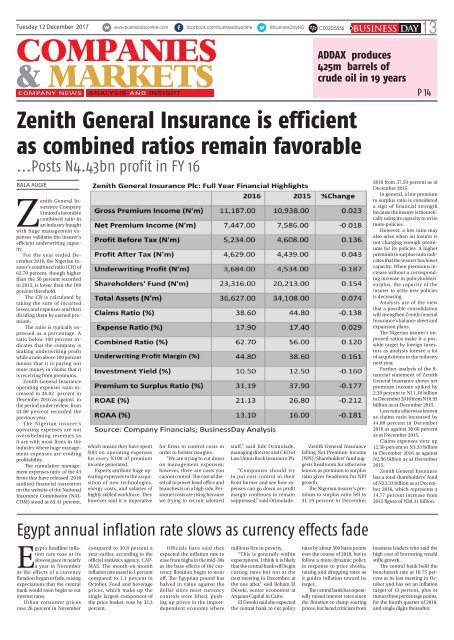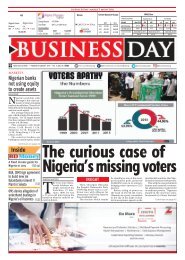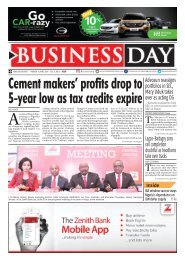BusinessDay 12 Dec 2017
You also want an ePaper? Increase the reach of your titles
YUMPU automatically turns print PDFs into web optimized ePapers that Google loves.
Tuesday <strong>12</strong> <strong>Dec</strong>ember <strong>2017</strong> C002D5556 BUSINESS DAY 13<br />
COMPANIES<br />
& MARKETS<br />
Company news analysis and insight<br />
ADDAX produces<br />
425m barrels of<br />
crude oil in 19 years<br />
P 14<br />
Zenith General Insurance is efficient<br />
as combined ratios remain favorable<br />
...Posts N4.43bn profit in FY 16<br />
BALA AUGIE<br />
Zenith General Insurance<br />
Company<br />
Limited’s favorable<br />
combined ratio in<br />
an industry fraught<br />
with huge management expenses<br />
validates the insurer’s<br />
efficient underwriting capacity.<br />
For the year ended <strong>Dec</strong>ember<br />
2016, the Nigerian insurer’s<br />
combined ratio (CR) of<br />
62.70 percent, though higher<br />
than the 56 percent recorded<br />
in 2015, is lower than the 100<br />
percent threshold.<br />
The CR is calculated by<br />
taking the sum of incurred<br />
losses and expenses and then<br />
dividing them by earned premium.<br />
The ratio is typically expressed<br />
as a percentage. A<br />
ratio below 100 percent indicates<br />
that the company is<br />
making underwriting profit<br />
while a ratio above 100 percent<br />
means that it is paying out<br />
more money in claims that it<br />
is receiving from premiums.<br />
Zenith General Insurance<br />
operating expenses ratio increased<br />
to 26.02 percent in<br />
<strong>Dec</strong>ember 2016 as against in<br />
the period under review, from<br />
24.80 percent recorded the<br />
previous year.<br />
The Nigerian insurer’s<br />
operating expenses are not<br />
overwhelming revenues as<br />
it are with most firms in the<br />
industry where huge management<br />
expenses are eroding<br />
profitability.<br />
The cumulative management<br />
expenses ratio of the 43<br />
firms that have released 2016<br />
audited financial statement<br />
on the website of the National<br />
Insurance Commission (NAI-<br />
COM) stood at 83.41 percent,<br />
which means they have spent<br />
N83 on operating expenses<br />
for every N100 of premium<br />
income generated.<br />
Experts attribute huge operating<br />
expenses to the acquisition<br />
of new technologies,<br />
energy costs, and salaries of<br />
highly skilled workforce. They<br />
however said it is imperative<br />
for firms to control costs in<br />
order to bolster margins.<br />
“We are trying to cut down<br />
on management expenses;<br />
however, there are costs you<br />
cannot control. The cost of diesel<br />
oil to power head office and<br />
branches is on a high side. Personnel<br />
costs are rising because<br />
we trying to recruit talented<br />
staff,” said Jide Orimolade,<br />
managing director and CEO of<br />
Law Union Rock Insurance Plc<br />
“Companies should try<br />
to put cost control in their<br />
front burner and see how expenses<br />
can go down as profit<br />
margin continues to remain<br />
suppressed,” said Orimolade.<br />
Zenith General Insurance<br />
falling Net Premium Income<br />
(NPI) /Shareholders’ fund suggests<br />
headroom for otherwise<br />
known as premium to surplus<br />
ratio gives headroom for NPI<br />
growth.<br />
The Nigerian insurer’s premium<br />
to surplus ratio fell to<br />
31.19 percent in <strong>Dec</strong>ember<br />
2016 from 37.50 percent as at<br />
<strong>Dec</strong>ember 2015.<br />
In general, a low premium<br />
to surplus ratio is considered<br />
a sign of financial strength<br />
because the insurer is theoretically<br />
using its capacity to write<br />
more policies.<br />
However, a low ratio may<br />
also arise when an insurer is<br />
not charging enough premiums<br />
for its policies. A higher<br />
premium to surplus ratio indicates<br />
that the insurer has lower<br />
capacity. When premiums increase<br />
without a corresponding<br />
increase in policyholders’<br />
surplus, the capacity of the<br />
insurer to write new policies<br />
is decreasing.<br />
Analysts are of the view<br />
that a possible consolidation<br />
will strengthen Zenith General<br />
Insurance’s balance sheet and<br />
expansion plans.<br />
The Nigerian insurer’s improved<br />
ratios make it a possible<br />
target by foreign investors<br />
as analysts foresee a lot<br />
of acquisitions in the industry<br />
next year.<br />
Further analysis of the financial<br />
statement of Zenith<br />
General Insurance shows net<br />
premium income spiked by<br />
2.28 percent to N11.18 billion<br />
in <strong>Dec</strong>ember 2016 from N10.93<br />
billion as at <strong>Dec</strong>ember 2015.<br />
Loss ratio otherwise known<br />
as claims ratio increased by<br />
44.80 percent in <strong>Dec</strong>ember<br />
2016 as against 38.60 percent<br />
as at <strong>Dec</strong>ember 2015.<br />
Claims expenses were up<br />
<strong>12</strong>.50 percent to N3.33 billion<br />
in <strong>Dec</strong>ember 2016 as against<br />
N2.96 billion as at <strong>Dec</strong>ember<br />
2015.<br />
Zenith General Insurance<br />
has a total shareholders’ fund<br />
of N23.33 billion as at <strong>Dec</strong>ember<br />
2016, which represents a<br />
14.77 percent increase from<br />
2015 figure of N20.31 billion.<br />
Egypt annual inflation rate slows as currency effects fade<br />
Egypt’s headline inflation<br />
rate rose at its<br />
slowest pace in nearly<br />
a year in November<br />
as the effects of a currency<br />
flotation began to fade, raising<br />
expectations that the central<br />
bank would soon begin to cut<br />
interest rates.<br />
Urban consumer prices<br />
rose 26 percent in November<br />
compared to 30.8 percent a<br />
year earlier, according to the<br />
official statistics agency, CAP-<br />
MAS. The month-on-month<br />
inflation rate eased to 1 percent<br />
compared to 1.1 percent in<br />
October. Food and beverage<br />
prices, which make up the<br />
single largest component of<br />
the price basket, rose by 32.3<br />
percent.<br />
Officials have said they<br />
expected the inflation rate to<br />
ease from highs in the mid-30s<br />
as the base effects of the currency<br />
flotation begin to wear<br />
off. The Egyptian pound has<br />
halved in value against the<br />
dollar since most currency<br />
controls were lifted, pushing<br />
up prices in the importdependent<br />
economy where<br />
millions live in poverty.<br />
“This is generally within<br />
expectations. I think it is likely<br />
that the central bank will begin<br />
cutting rates but not at the<br />
next meeting in <strong>Dec</strong>ember, at<br />
the one after,” said Reham El<br />
Desoki, senior economist at<br />
Arqaam Capital in Cairo.<br />
El Desoki said she expected<br />
the central bank to cut policy<br />
rates by about 500 basis points<br />
over the course of 2018, but to<br />
follow a more dynamic policy<br />
in response to price shocks,<br />
raising and dropping rates as<br />
it guides inflation toward its<br />
target.<br />
The central bank has repeatedly<br />
raised interest rates since<br />
the flotation to damp soaring<br />
prices, but faced criticism from<br />
business leaders who said the<br />
high cost of borrowing would<br />
stifle growth.<br />
The central bank held the<br />
benchmark rate at 18.75 percent<br />
at its last meeting in October<br />
and has set an inflation<br />
target of 13 percent, plus or<br />
minus three percentage points,<br />
for the fourth quarter of 2018,<br />
and single digits thereafter.


















